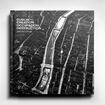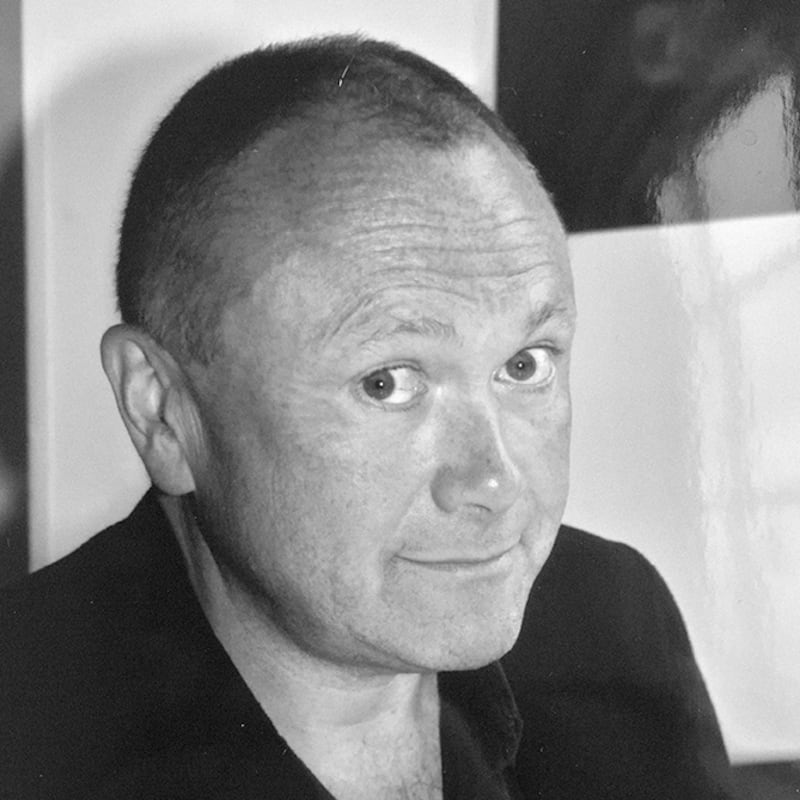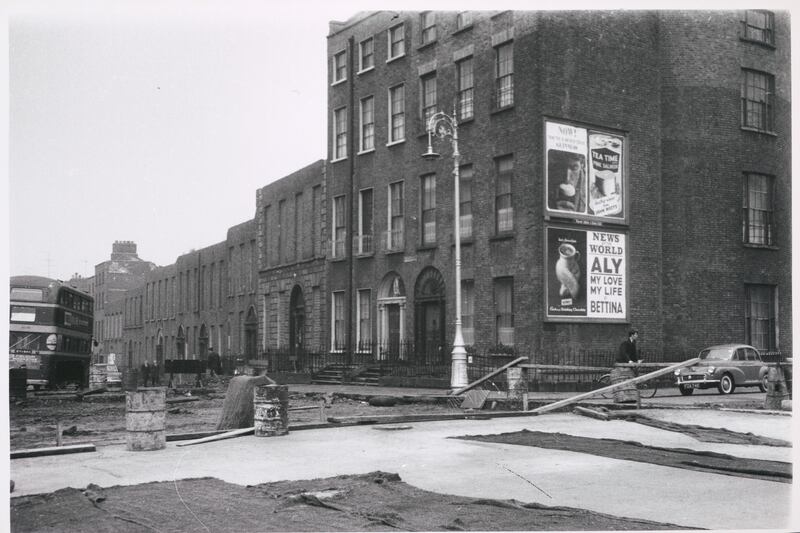
Looking at what we have lost is always double-edged. Poignancy is tinged with wonder — or is that the other way around? — as we reconsider what might have been taken for granted, in the light of it being gone. Niall McCullough’s exploration of absent cityscapes and streets is a dual elegy: both for vanished buildings and vistas, and for the author and architect himself, who died in 2021, just as he was completing the text of this book.
Taking a different path from his previous investigations of Dublin, McCullough shapes a collection of essays around an extended series of images, which are more visual poems than photo-documentary. In this way, the book becomes a lament for, and a celebration of all the elements that we lose when we lose parts of our built past: from fragments to entire streets, and even whole city quarters.

In the introduction, movingly subtitled “A Ghost at the Table,” McCullough, who always wrote like an angel, describes how Dublin had survived the excessive bombings of the second World War, which had destroyed huge parts of its sister capitals across Europe. “In a world inured to widespread destruction, the city of Dublin stood poor, materially exhausted, but substantially intact.” What happened next could be blamed on no one but ourselves.
James Joyce once wrote that you could reconstruct Dublin from the pages of Ulysses. While probably impossible in a practical sense, it is certainly true emotionally, for Joycean devotees at least. Through the often grainy, sometimes sharp photography, smattered with the occasional maps that guided McCullough’s fascination with the shapes of cities and towns, a spectral sense of a former Dublin emerges.
READ MORE
If McCullough wrote like an angel, he also wrote with a depth of humanity and wisdom. The loss of so much of the city mattered to him because with each thoughtless demolition, he realised that we have severed another connecting thread to the stories of a collective past. “When context is dislocated,” he writes. “Meaning is dislodged; sometimes — as in Dublin — the rupture is so huge that it creates a caesura, a loss of memory and a diminution of possibility with subtle and profound implications; we walk and see differently.”
The passages of photographs may at first seem disconnected themselves. With simple, reduced captions: just a location, and a credit; one may be initially at a loss to wonder how to find a way into what is going on. What am I supposed to be seeing? Thinking? Then it creeps up and coalesces: the carefully chosen itinerary of images becomes a visual walking tour, so much so that you can almost imagine what it must have been like to turn a corner and arrive at Crampton Court on that particular day, to feel the play of light and shadow, as the air grows cooler on stepping out of the sunlight.
Chimneys rise at Kearn’s Place, Kilmainham, with whitewashing shining in the foreground, hinting at the pride of those who lived in what clearly appears to be on the run-down side of squalor. Valerie Mulvin, who worked to assemble the images from the numerous research files McCullough had amassed, says that he had decided the layout “almost completely” before she was necessitated to take on the task, with the help of designer, Colin Farmer.
“He was working on it up to the week before he died,” she says. Her task was made more difficult by her late husband’s prodigious memory. “He knew where everything was, where everything went, and he had a brilliant recall.” That meant that a certain amount of detective work was needed to track down original copies of the various images ahead of publication.
Yet more detective work had already been done by the pair in the years preceding this publication, as many of the images McCullough had found were not fully labelled. “We would go for walks, and work out where something must have been from a steeple in the background, or the angle of a street,” Mulvin says.
Not everything pictured is gone. The post-insurrection wreckages of the Custom House and Four Courts feature, now of course, restored. Some of the losses, such as whole Georgian terraces, are well known. Other images conjure up more unfamiliar things: Turkish Baths at Lincoln Place, a racquet court at Winetavern Street, a series of oblong boxes — air raid shelters dropped into place at the height of the Emergency, fake city gates built on Leeson Street for the visit of Queen Victoria.
Another series of images shows similarities within a city that had a strong plan behind it, despite the layers of creation and occupation. Hardwicke Street to St George’s Church, Great Charles Street to Free Church, the Gate Theatre and Sackville Mall, City Hall and Dame Street, and Foster Place and Parliament House (now Bank of Ireland) all echo one another in aspect. Elsewhere, there are photo-essays within photo-essays, exploring such topics as public infrastructure. Here, a map introduces the river as a former transport and city hub. The map’s orientation, which shows the traditional North-South view of the city is an interesting counterpoint to the cover image with its different way of looking at things. From East to West, a different axis of avenues appears.

McCullough loved maps. “There is a moment when you see into a city’s heart and begin to understand its nature,” he writes. “My appreciation of Dublin crystallized around the study of old maps.” Using John Roque’s famous 1765 map of Dublin, and comparing it to the 1748 Nolli Map of Rome, he sees similarity as well as difference, with resemblances in the still just-about traceable lines of prehistoric routes of travel. Likewise, both cities are shaped in places around former markets, but Dublin “has undergone such spatial destruction” that it is a shock to see how recently we have lost many, such as “the back-to-back triangular market spaces in Kevin Street, which lasted until the 1960s”.
How much do these losses matter? An architect who excelled in sensitivity for the meanings, and feeling of place, and for his understanding of older buildings, McCullough was alive to their potential for reuse. He and McCullough Mulvin achieved this notably, and beautifully, with such buildings as Rush Library in a former church, and Kilkenny’s Butler Gallery in a former Almshouse on the banks of the river Nore.
“I have always loved the awkward beauty of old structures and thought there was something more to be made of these conditions,” McCullough wrote in this newspaper in 2014, on the publication of his book, Palimpsest. “There must be some lost chord that would open up Irish views about architecture,” he adds. “Finding reasons why old buildings should be reused is not difficult, especially when you think about it in a fairly cold-blooded way: these rooms, facades, roofs, cloisters, galleries, staircases, shops are useful things.” Just under a decade later, he might have added the point about embodied carbon. Today, if we can reuse, reshape, repurpose, we must.
Throughout the book, we can discover the rich resources of such institutions as The Irish Architectural Archive, City Library, National Library and the Office of Public Works. RTÉ also has a strong vein of architectural photography in the form of the Nevill Johnson Collection of images taken between 1952 and 1953, which can be viewed online at rte.ie. Black and white vistas do, however, invite us to view the past as a grim and colourless place, and so it is worth re-picturing some images, with their shopfronts and advertising, animated with people, and children playing in brighter tones; showing a city alive with occupation, creativity and commerce.
The overall tone is, however, grim, especially as we get to the concluding chapter: Destruction. While progress cannot happen without some replacement of the old, the scale of the Dublin demolitions is huge. The Bride Street area is flattened, cleared for Iveagh Trust housing; and on a more individual note, the shadowy figure of writer Anthony Burgess stands above the ruins of Leopold Bloom’s Ulysses address at 7 Eccles Street.
Alongside these intriguing images, what lifts the book from other explorations of city planning carnage is the highly considered pacing of the photography, and the beauty, and insight of the framing essays. “Destruction and decay are mesmeric […] Architecture’s random death, the unexpected slicing of heavy things governed by gravity, grants a freedom to wander through unmediated words between floors and across buried courtyards.” For those lucky enough to have known him, you can hear McCullough’s voice.
Ruins, he notes, have always affected sensibilities, and “dead houses become weightless, released from the energy of centuries”. Architecture in construction, and destruction, parallels art, “shimmering in and out of view”. You can regret that he is not here to discuss, and even perhaps argue the finer points of his points, but at least we have his buildings, and we now have this book.
Further reading
Dublin an Urban History (Anne Street Press). Niall McCullough’s study of the shape of the city, explores its story from ancient times. From the processional routes of the Slighe to the present day, it is a brilliant read, rich with stories and images. First published in 1989, and updated in 2007, copies are available from annestreetpress@mcculloughmulvin.com
Dublin Then and Now (Pavilion Books, 2018). Lisa Marie Griffin takes images of the old city and matches them with contemporary views. Explore Trinity College, Dublin Castle, the Guinness Brewery, Brazen Head, O’Connell Street and more.
A Little History of the Future of Dublin, Frank McDonald follows up his powerful polemics: The Destruction of Dublin, The Construction of Dublin, Chaos at the Crossroads and The Builders. Here he looks at visions of the future of the city through the ages, and comes up with a plan for things to come. Martello Publishing, 2021.













